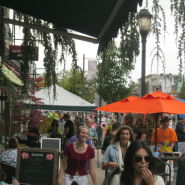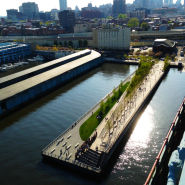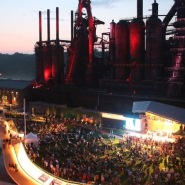posted on February 10th, 2015

Congratulations to the 2014 Great Places in PA Award Winners!
The Pennsylvania Chapter of the American Planning Association is proud to announce our Great Places for 2014 in two categories: Great Neighborhoods and Great Public Spaces. Great Places are unique, memorable places that work not only for their community, but as a model others want to emulate – places of exemplary character, quality, planning, identity, cultural interest, and community involvement with a sustainable vision for tomorrow.
|
Neighborhoods
 Downtown West Chester, West Chester Borough Downtown West Chester, West Chester Borough
In 2000, with commercial downtown property values declining, the West Chester Business Improvement District (BID) was formed to re-establish downtown as a destination. Improvements, such as new sidewalks, parking garages, bike racks/lockers, solar trash/recycling cans, and flower planters helped to revitalize the downtown and resulted in much success. Today, the downtown is thriving with a multitude of restaurants, shops, banks, governmental offices, and professional services. The original four-square block downtown, laid out in 1784, has become the Borough’s “Old Town” historic district. A series of historical interpretive signs tell the story of the Borough. Dozens of downtown community events attract thousands to the downtown and creates vibrancy in both the daytime and evening hours. The BID, guided by the Borough’s Downtown Plan, Comprehensive Historic Preservation Plan, and Comprehensive Plan, continues to work diligently to maintain and improve the accessibility, walkability, and attractiveness of downtown.
|
 The Strip District, Pittsburgh The Strip District, Pittsburgh
The Strip District is Pittsburgh’s only remaining historic market district. This old-world-style marketplace is abuzz with shoppers patronizing wholesalers, fish/produce merchants, ethnic food shops, antique galleries, specialty shops, textile/interior design firms, and sidewalk vendors. Multi-generational family businesses sit side-by-side with small niche businesses passionate about their craft. Small businesses, as well as innovative high-technology, marketing, public relations, and other professional firms, continue to gravitate to The Strip, making it a hub for job growth. Additionally, it offers residential properties, warehouses, a world-class museum, an international crafts gallery, a theater group, two historic churches and a variety of nightspots, ranging in style from upscale lounges to cozy pubs. Overall, it provides a captivating opportunity to explore an innovative re-imagining of obsolete urban industrial spaces.
|
 West End Theatre District, City of Allentown West End Theatre District, City of Allentown
Allentown’s western gateway, known as the West End Theatre District, developed in the first half of the 20th century. It has an eclectic mix of single homes, ranging from 1910-1930 Colonial Revival to 1960’s mid-century modern, and is host to a variety of retail stores, restaurants and several cultural gems. The Civic Theatre, a 1928 art-deco building that hosts live performances, anchors the burgeoning business district of this traditional, walkable neighborhood. Another gem, the Allentown Fairgrounds Farmer’s Market, is one of the last places in the Lehigh Valley where farmers and merchants can sell fresh goods weekly. The Fairgrounds property also hosts The Great Allentown Fair each August, drawing over one million people annually to experience agriculture, fun, food, and entertainment. Culturally rich, business friendly, and ethnically diverse, the West End Theatre District is a leading Allentown neighborhood and a destination for residents, visitors, college students, entrepreneurs, and artisans.
|
 West Reading: The Avenue, Center Point & Ten Points, Berks County West Reading: The Avenue, Center Point & Ten Points, Berks County
West Reading is a densely populated 15-block area built on a human scale in the late 19th and early 20th centuries for factory and mill workers. It includes a five-block business district (The Avenue) and surrounding residential areas (Center Point and Ten Points). Today, The Avenue is a mix of distinctive shops and diverse dining destinations. It hosts a variety of community events, attracting visitors from the surrounding region. A recent streetscape project resulted in infrastructure improvements and upgraded amenities. In Center Point and Ten Points, attractively painted homes, flowerpots, public art, and canopy streets are prevalent. Residents take pride in the community and are willing to work to make it better. The Community Revitalization Foundation, a partnership of residents, business leaders and government officials, plans, sets goals, and measures successes. West Reading boasts that it is small town America with urban sophistication and a fun place to play, where visitors are greeted with beauty and romanced with color.
|
Public Spaces
 Allen Street & College Avenue Intersection, State College Borough Allen Street & College Avenue Intersection, State College Borough
Commonly referred to as “The Corner,” this area is home to a thriving mix of residential, commercial and academic uses. It serves as a critical link between the front door to Penn State University (the “Gates of Old Main”) and downtown State College. In addition to its iconic image as the center point of town-gown connectivity, it is an important multi-modal transportation hub, a year-round popular gathering place, and focal point for many community events. Of particular note is the Central Pennsylvania Festival of the Arts, which attracts art exhibitors from around the world. According to the Downtown State College Master Plan, the overall concept is to establish this intersection as the “town square.” Many streetscape design enhancements and innovative practices are proposed to further enliven this public space.
|
 Race Street Pier, City of Philadelphia Race Street Pier, City of Philadelphia
Race Street Pier is a one-acre park situated in a highly visible location along Columbus Boulevard, just north of Penn’s Landing, with breathtaking views of the Delaware River and Benjamin Franklin Bridge. In keeping with the history of the original 1890’s waterfront Pier, the physical design of the revitalized Pier is split into two levels – an upper level with a grand sky promenade and a lower level for passive recreation and social gathering. Additionally, two of the original wharf drops, which were used for unloading cargo, have been covered with grating to allow visitors to view the sub-structure of the Pier, as well as the River itself, in an authentic and unusual way. Race Street Pier is a popular gathering place and has served as catalyst to stimulate development of nearby properties, thereby transforming the waterfront into a vibrant space for residents, visitors and businesses.
|
 Steel Stacks Campus, City of Bethlehem Steel Stacks Campus, City of Bethlehem
The Steel Stacks Campus sits directly at the foot of the iconic blast furnaces of the former Bethlehem Steel site. In 2004, the National Trust for Historic Preservation listed it as one of the Country’s most endangered historic sites. However, through community engagement, planning, and creative design/placemaking, this unique site has been transformed into a community asset that incorporates many of the original historic characteristics. Stack House, the oldest building on the Campus, has been restored into the Visitors Center and the outdoor music venues make full use of the site’s spectacular views. Today, this thriving mixed-use public space is home to many community events, festivals and concerts that attract well over one million residents and visitors annually. Connectivity to the surrounding neighborhoods assists in the success of the Campus and allows the neighborhoods to share in the growth and success of the site as well.
|
A special thanks to our 2014 Great Places judges
Chair of Great Places Initiative: Pam Shellenberger, AICP, York County Planning Commission
Judges:
Lance Chimka, Manager, Business Development
Allegheny County Economic Development
Julie Fitzpatrick, Assistant Director/Special Projects Coordinator
PA Downtown Center
Tom Hylton, Founder
Save Our Land, Save Our Towns Inc.
Sidney R. Kime, Jr., RLA, FASLA, Studio Director
The ELA Group (Lititz)
Scott Page, Principal
Interface Studios (Philadelphia)
Jim Segedy, FAICP, Director, Community Planning + Design
The Planning Guild
Gordon Turow, Director, Campus Planning and Design
Penn State University
Laura Wolf-Powers, PhD, Assistant Professor of City & Regional Planning, Penn Design
University of Pennsylvania








 Race Street Pier, City of Philadelphia
Race Street Pier, City of Philadelphia